
Switzerland - tpc - Transports Publics du Chablais
For a full scale picture, please click on the picture shown !
tpc - Transports Publics du Chablais
tpc or Transports Publics du Chablais was set up 1999-2000 as a result of merger talks of four independent railroad companies:
Aigle-Leysin (AL); Aigle-Ollon-Monthey-Champéry (AOMC); Aigle-Sépey-Diablerets (ASD) and Bex-Villars-Bretaye (BVB).
However, it's not a full merger of these companies, they still run some operations with their own names. tpc is just called an
"operating community" and actually tpc as a common marketing and administration organisation existed already since 1975. But now
gradually a real fusion is taking place. The trains of these companies are not all mutually compatible. They all use
meter gauge, but they have several different electric systems and some use rack rails, some do not, and even the rack rails were
of two different systems. But there is some standardisation going on. For example in 2016 the whole network of AOMC was changed
from 950 V DC to 1500 V DC, which is used at some of the other networks
and all their rack rails were changed from the system Strub to the system Abt. This means of course that the old trains can no longer
run on their traditional routes, but the target is to get to a uniform set of trains which can handle some different voltages
but nevertheless can run on a uniform track system.
AL's line is 6,2 km long and is electrified with 1500 V DC. AOMC is 23 km long and was earlier electrified with 850 V DC > 950 V DC,
now 1500 V DC, ASD's line is 23 km with also 1500V DC and BVB's line is 17 km with 650 V DC.
AL - Aigle-Leysin railway
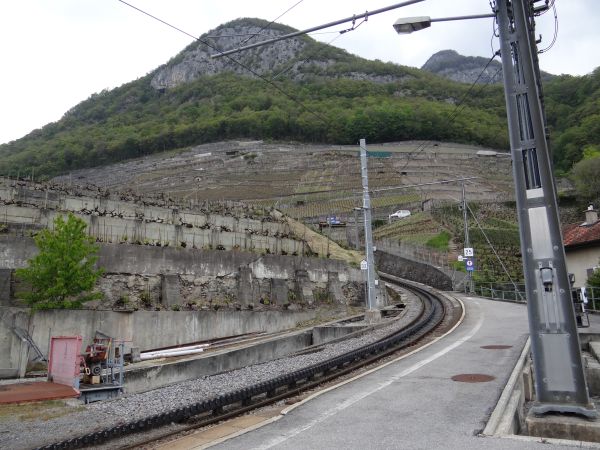
A view showing how the track of the railway company AL, Aigle - Leysin begins its climb from Aigle upwards through the wineyards
of the region. AL has a 6,2 km long line climbing from Aigle to the ski resort of Leysin. It is metre gauge and electrified with
1500 V DC. The line is equipped with a rack-rail using the Abt rack system. Maximum incline is 23%. AL's railway was the first
narrow gauge railway in the Chablais region around Aigle.
Picture 2.5.2016 by Ilkka Siissalo.
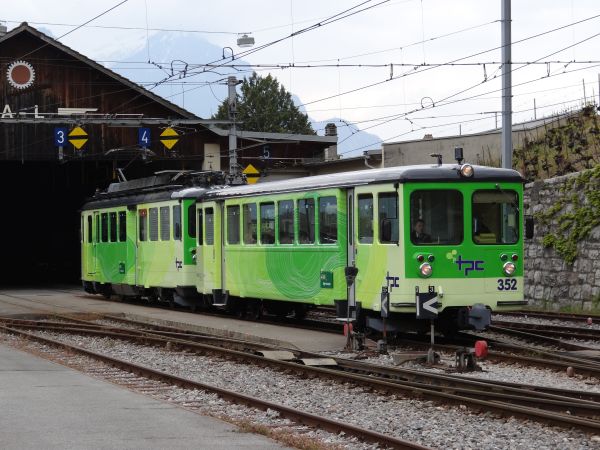
A train just about to leave AL's depot near Aigle. The steering cab coach which can be seen first is Bt 352 built by SIG and SAAS
in 1966. Behind it motorwagon of the type BDeh 2/4, no.301. AL has two of them, 301 and 302. They are from 1966.
Picture from Aigle 2.5.2016 by Ilkka Siissalo.
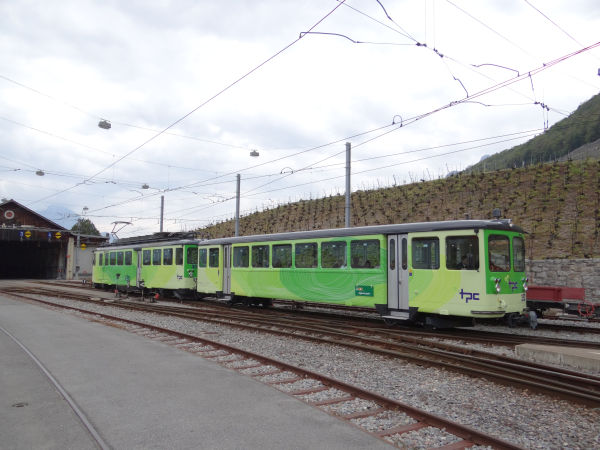
Same train as above, just a moment later.
Picture from Aigle 2.5.2016 by Ilkka Siissalo.
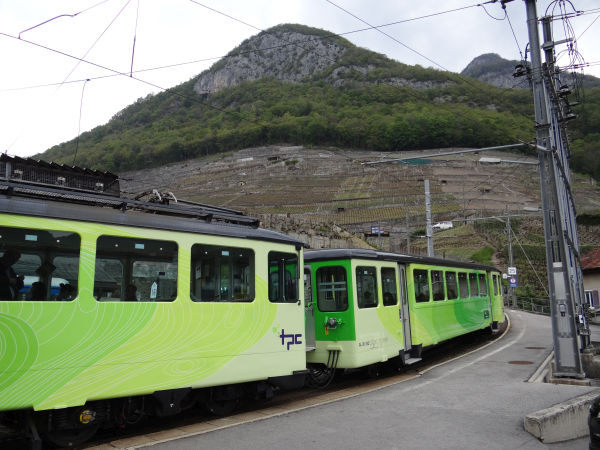
Still the same train as above, now beginning its very steep climb up through vineyards and mountain forests.
Picture from Aigle 2.5.2016 by Ilkka Siissalo.
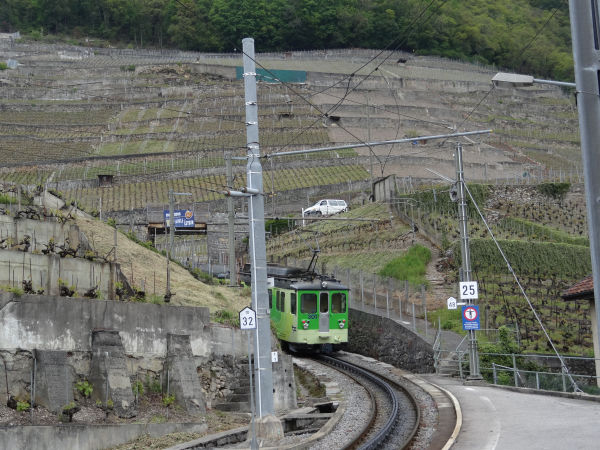
There it goes... Bye-bye.
Picture from Aigle 2.5.2016 by Ilkka Siissalo.

This motorwagon is the BDeh 2/4 no.302, similar to the one shown above, but here it was still in AL's original brown and creme
livery.
Picture from Aigle Gare, main station 3.5.2016 by Ilkka Siissalo.
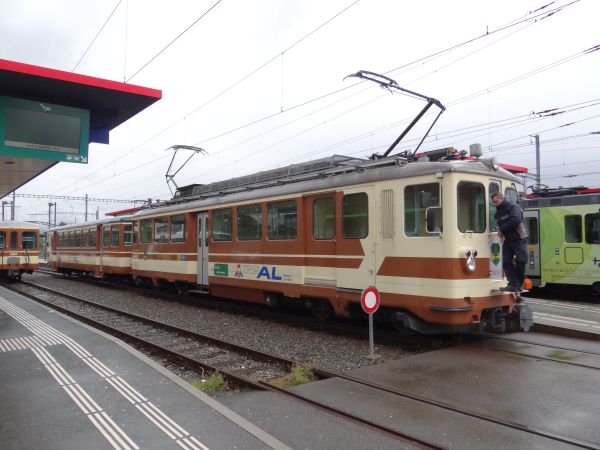
Same train as above; here the train driver is entering his motowagon via the front door. Note how it is necessary to use
both pantographs simultaneously due to the low voltage.
Picture from Aigle Gare, main station 3.5.2016 by Ilkka Siissalo.
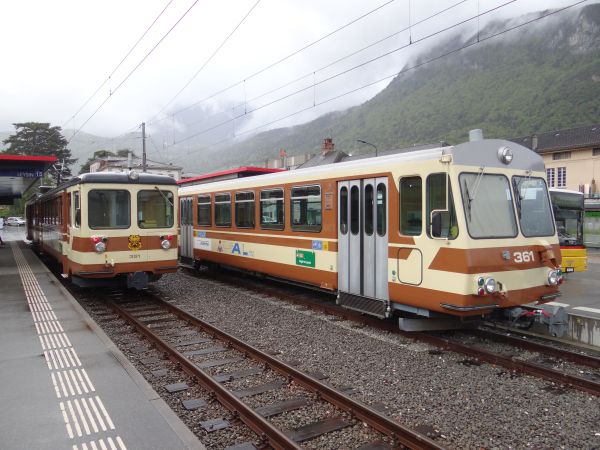
AL's trains still in the company's old brown livery. Both are steering cab coaches. Bt 351 on the left is from the year 1966,
Bt 361 on the right is from 1987.
Picture from Aigle Gare, main station 3.5.2016 by Ilkka Siissalo.
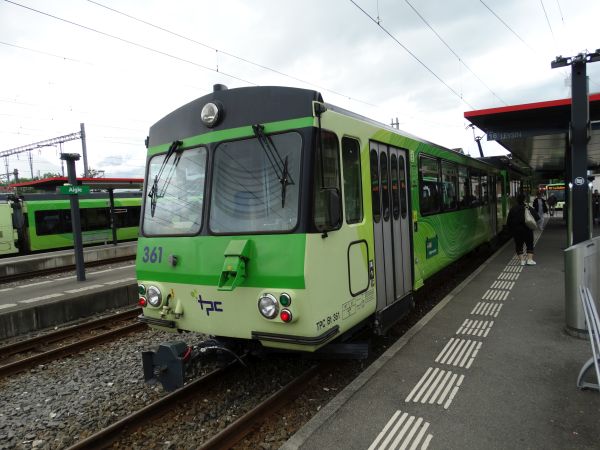
Exactly the same steering cab coach Bt 361 as shown above, but now painted and taped in tpc's new standard green colours.
Picture from Aigle Gare 10.5.2023 by Ilkka Siissalo.
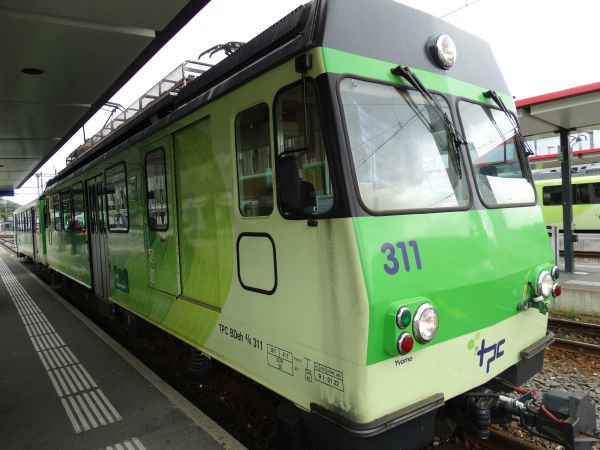
At the other end was this motorwagon BDeh 4/4 no.311. For an older picture of the same, scroll down two pictures...
Picture from Aigle Gare 10.5.2023 by Ilkka Siissalo.
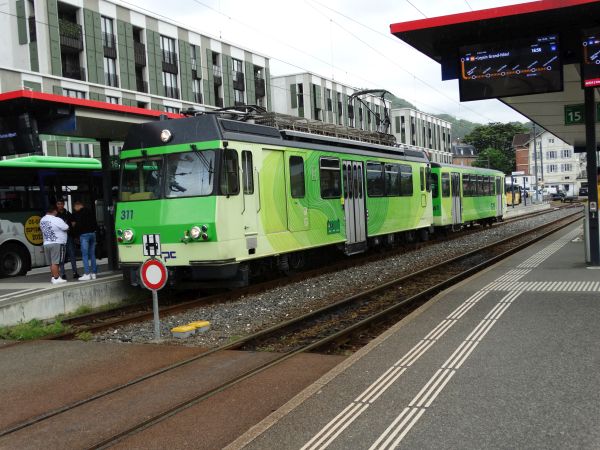
Still the same combination, motorwagon BDeh 4/4 311 plus steering cab coach Bt 361 ready to leave from Aigle to Leysin.
Picture from Aigle Gare 10.5.2023 by Ilkka Siissalo.
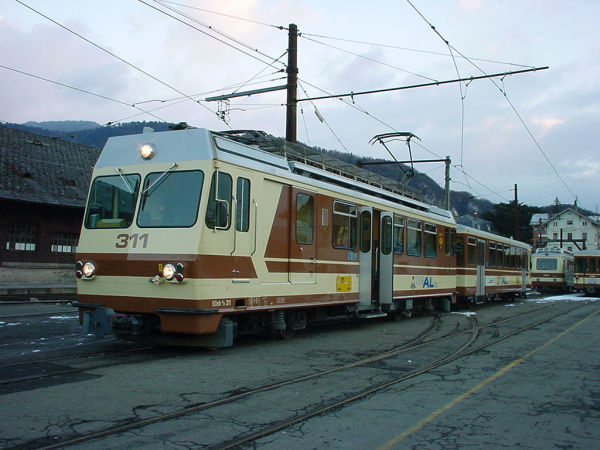
AL's motor wagon BDeh 4/4 no.311 is from 1987 from a series of only three motorwagons, numbered 311-313. They were built by
Ateliers de constructions mécaniques de Vevey. In the background one of the 1940s motorwagons of AL.
Picture from Aigle Gare, main station 3.5.2016 by Ilkka Siissalo.
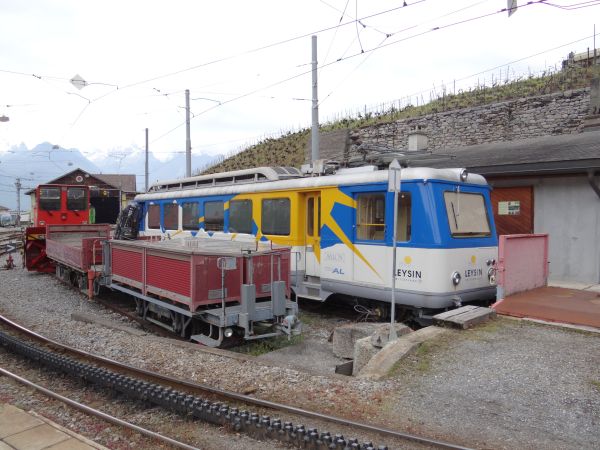
A view from just outside Aigle, from the depot of AL. The blue, white and yellow wagon behind the gravel and sand wagons is
Arseh 2/4 no.201 (former motorwagon BDeh 2/4 no.201), a motorwagon from 1946, which has been converted into a first class
restaurant named "Flèche". But it's not always in use - like just at the point of time when this photo was taken on 2.5.2016.
Picture by Ilkka Siissalo.
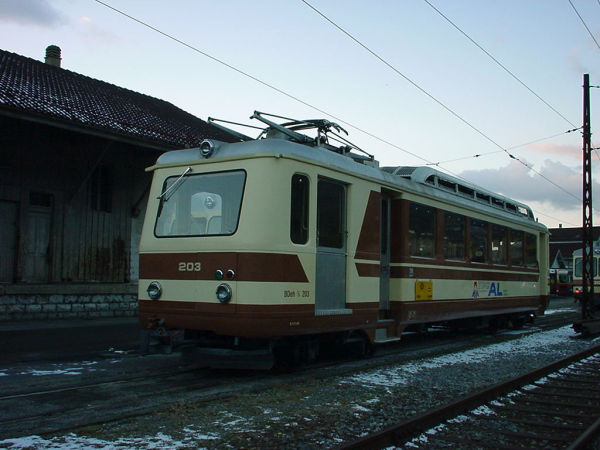
This motorwagon BDeh 2/4 no.203 is similar to the no.201 which was converted into a restaurant and is shown above. They are both
from the 1940s. Despite its age, it was still in active use in 2001.
Picture from Aigle Gare 29.12.2001 by Ilkka Siissalo.
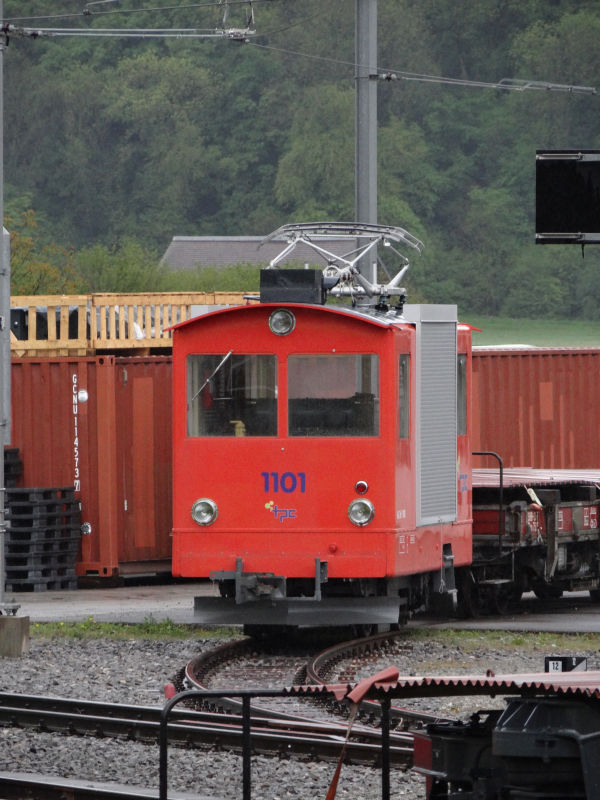
AL's small, old electric shunter locomotive Te 2/2 no.1101 has mainly been used within the depot area in Aigle. The small
machine dates back to 1949, although it has been thoroughly modernised.
Picture from the depot at Aigle 3.5.2016 by Ilkka Siissalo.
Aigle-Ollon-Monthey-Champéry AOMC
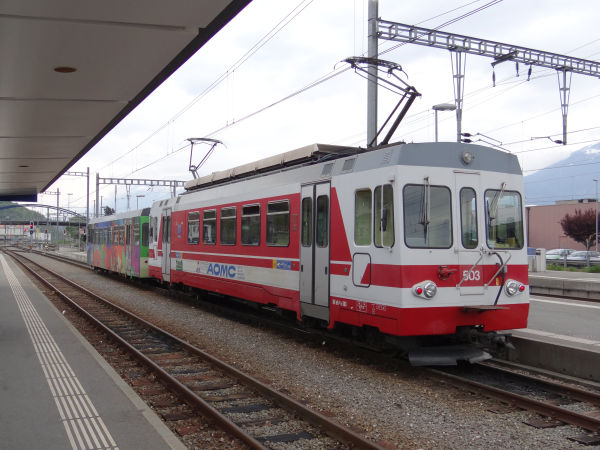
Aigle-Ollon-Monthey-Champéry railroad AOMC used to be electrified with 850V DC but was recently converted to 1500 V DC, which of course meant
that all the old trains had to be taken out of use. The line is 23 km long and uses partly a rack-rail, this time the system Strub rack rails.
The maximum gradient of the line is 135 promilles (13,5%) and the end station at Champéry lies at 1049 metres above sea level, which means a
climb of 645 metres up from Aigle, where the line begins. For many years AOMC's trains used to be red and creme, but now they are also being
painted in the uniform green colours of tpc.
Here we see AOMC's motor wagon BDeh 4/4 no.503 named "Europe", built in 1992, here before the change of voltage. This is still from the 850V DC days.
Picture from Aigle 2.5.2016 by Ilkka Siissalo.
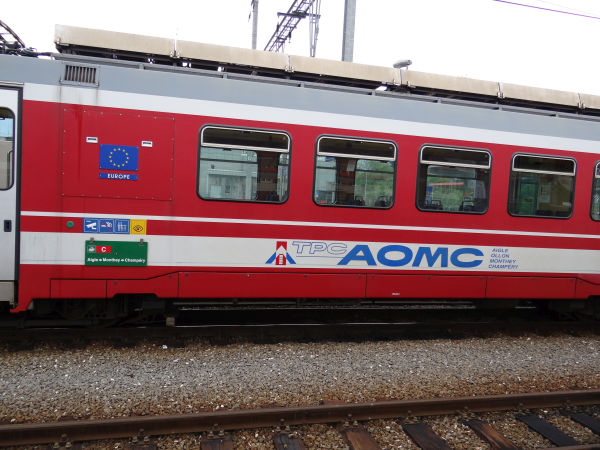
Side view of the same motorwagon as shown above. It was already marked as tpc's "line C" but it still carried AOMC's traditional red and creme
or red and white colours. Note the name of the motorwagon "Europe". Most of the other AOMC motorwagons were named after stations along the
AOMC line.
Picture from Aigle 2.5.2016 by Ilkka Siissalo.
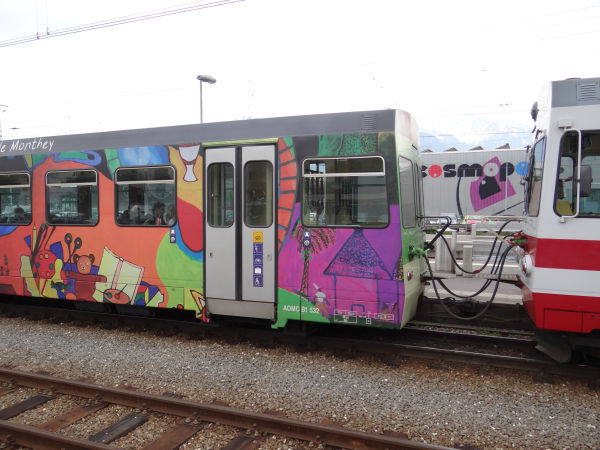
Some of AOMC's wagons were traditionally painted or taped to be rather colourful, sometimes totally forgetting what would look stylish
and nice. This is the steering cab coach Bt 532.
Picture from Aigle 2.5.2016 by Ilkka Siissalo.
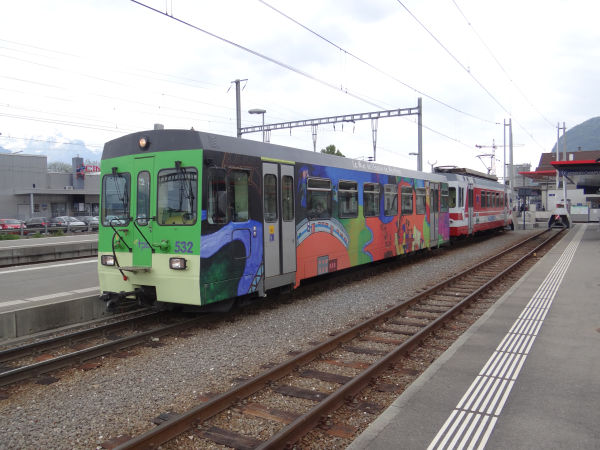
The same train as above, steering cab coach Bt 532 first. That taping looks pretty awful, doesn't it?
Picture from Aigle 2.5.2016 by Ilkka Siissalo.
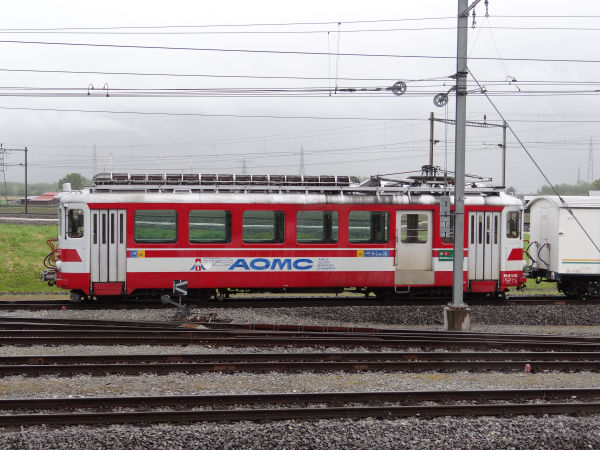
This older generation motorwagon is also classified as AOMC BDeh 4/4, but now number 514. There were four of these and they were from
the year 1954. They were taken out of active use when AOMC's voltage was changed to 1500 V in 2016.
Picture from Aigle depot 3.5.2016 by Ilkka Siissalo.
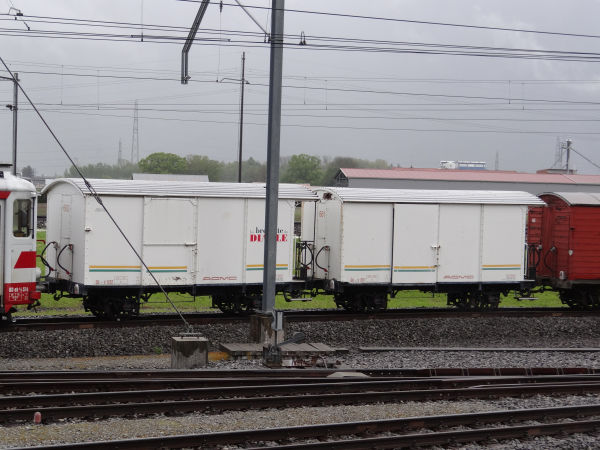
Old cargo wagons of AOMC. The white ones were for cooled products. The AOMC trains climb quite high up on the mountainsides and they remain
an important means for cargo transport for the small villages high up there.
Picture from Aigle depot 3.5.2016 by Ilkka Siissalo.

These Beh 4/8 trains are from the turn of the millennium and they have already so far changed owners within the tpc group several times.
Here we see one of them in AOMC's then new colours as AOMC Beh 4/8 no.591. Later it served for the company ASD again as no 591, but
now it's at BVB as their no.91. See below for more pictures of these similar trains.
Picture from Aigle depot 29.12.2001 by Ilkka Siissalo.
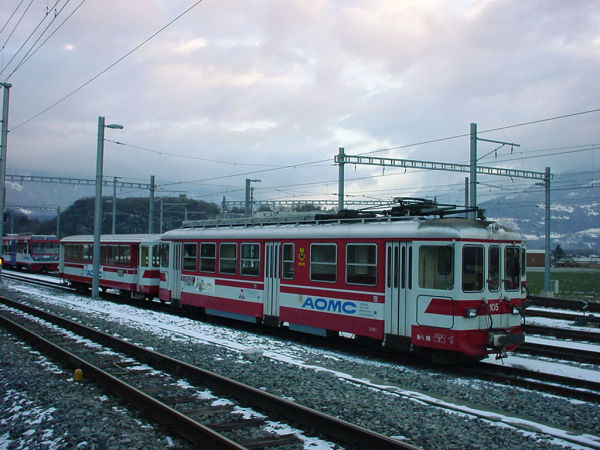
These Be 4/4 motorwagons were from the year 1966. They were built by Schindler Waggon and Brown Boweri for Birsigtalbahn by the city
of Basel and operated there as their Be 4/4 numbers 11 to 16. When the Baselland Transport cantonal tram company took over Birsigtalbahn
and converted it to be run by trams instead of trains, AOMC bought them in 1984. Only one is left now. They were pure adhesion rail
trains with no cog wheel machinery, so they could only be used on the flatland part of AOMC's network.
Picture from Aigle depot 29.12.2001 by Ilkka Siissalo.
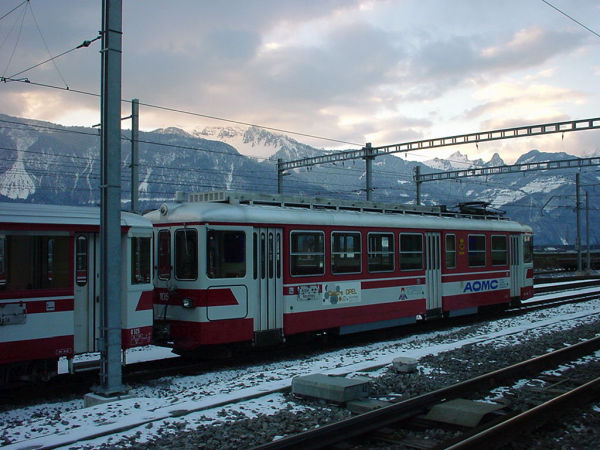
The same Be 4/4 motorwagon 105 as above, now seen from the other direction. It doesn't much look like a tram, yet the successors of
these trains in Basel region were typical city trams on the same tracks.
Picture from Aigle depot 29.12.2001 by Ilkka Siissalo.

These are the new Stadler made ABeh 2/6 trains now replacing the old AOMC red and white motorwagons shown above. These are now
in use since 2016, after the traction voltage was changed to 1500 V DC. Here the new train was still missing part of its green stickers.
AOMC has now seven of these new trains.
Picture from Aigle depot 3.5.2016 by Ilkka Siissalo.
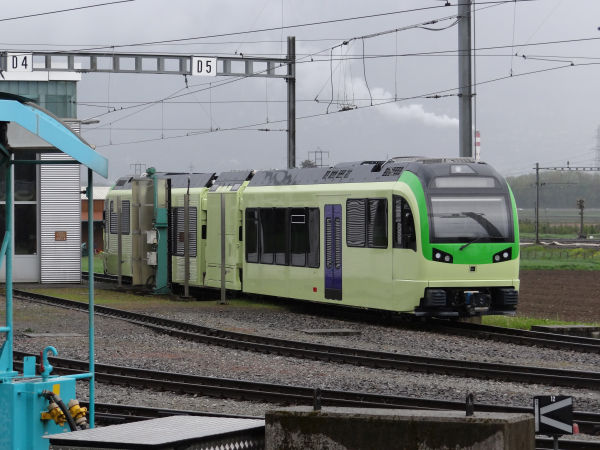
One of the new Stadler trains by the train washing line at Aigle depot.
Picture from Aigle depot 3.5.2016 by Ilkka Siissalo.
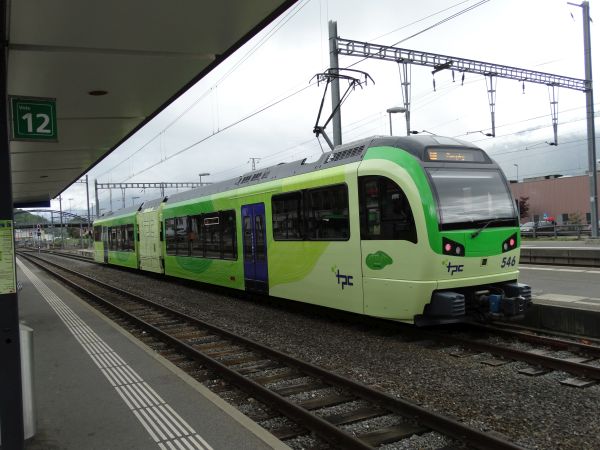
The new Stadler trains are now in full use and have also received their final livery and tapings. This is a fourth generation Stadler GTW 2/6, which has the
possibility of climbing up and down really steep slopes with the help of a cog wheel using system Abt rack rails. tpc is planning that in the near future when
all the rack rails of tpc networks have been changed to system Abt and all the electric systems have been converted to a uniform 1500 V DC, these trains could
run on all the lines of the four train companies forming now the present day tpc. In this beginning stage these new trains have operated only on the former
AOMC lines.
Picture from Aigle depot 10.5.2023 by Ilkka Siissalo.
Aigle-Sepey-Diablerets railway ASD
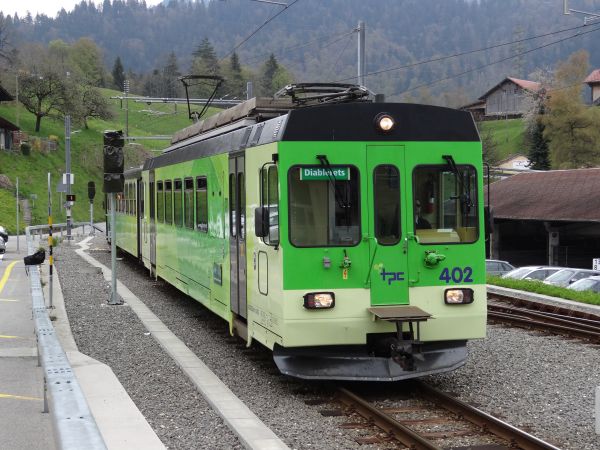
Aigle–Sépey–Diablerets railway ASD, now also called line D of tpc was opened for traffic in 1914. The line is 22,3 km long
and it climbs to the height of 1175 metres over sea level at Le Diablerets. The lowest point at Aigle station is at 404 m
over sea level, so the line climbs up more than 750 metres. Maximum slope is only 6%, so it is still all adhesion rail
technology with no rack rails. The line is electrified with 1500 V DC.
This train is ASD's BDe 4/4 no. 402, now painted in the colours of tpc. It is on its way from
Aigle to Les Diablerets and stopping here at the station of Le Sépey. Picture by Ilkka Siissalo 2.5.2016.
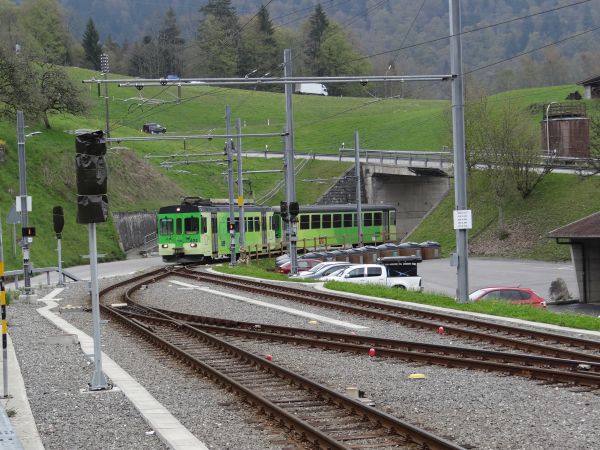
The same train as above, ASD's BDe 4/4 no. 402, here just approaching the station of Le Sépey. Le Sépey's station has been recently
totally rebuilt. The trains stopping there have to reverse direction when they continue. These trains used to be blue and white
before they were repainted to the new tpc livery of 2010. ASD has four of these, numbered 401 to 404. They are from 1987.
Picture from Le Sépey by Ilkka Siissalo 2.5.2016.
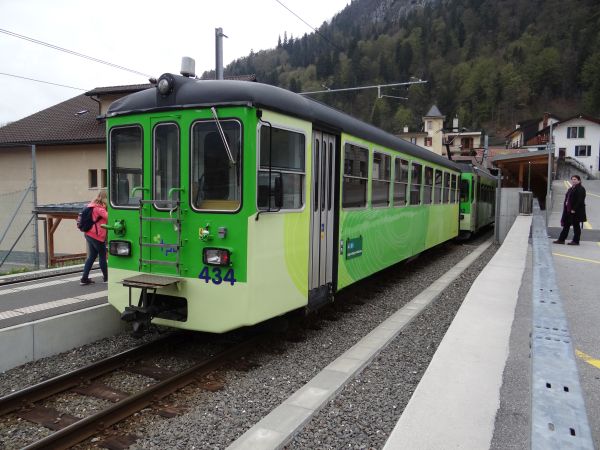
This was the driver's cab trailer wagon attached to the BDe 4/4 402 shown above. It is Bt 434, taken over by ASD from AOMC.
It was built by Schindler and BBC already in 1966.
Picture from Le Sépey by Ilkka Siissalo 2.5.2016.
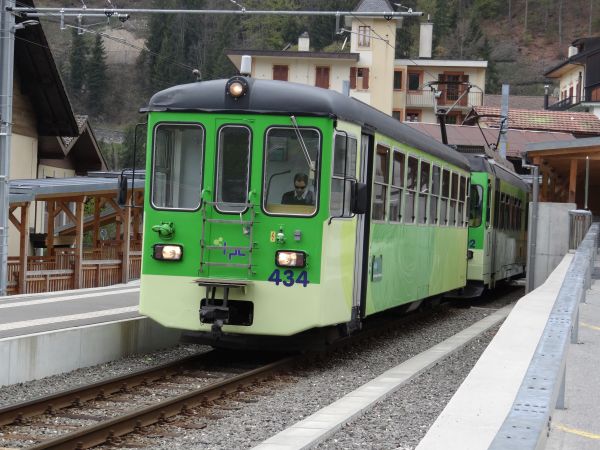
Another picture of the same train as it was ready now to continue towards Le Diablerets, this time now with the steering cab
wagon first. The train station at Le Sépey is built in such a way that trains cannot just ride through it. Both uphill and
downhill running trains turn to a siding to reach the station and they reverse their riding direction here when they continue.
Picture from Le Sépey by Ilkka Siissalo 2.5.2016.
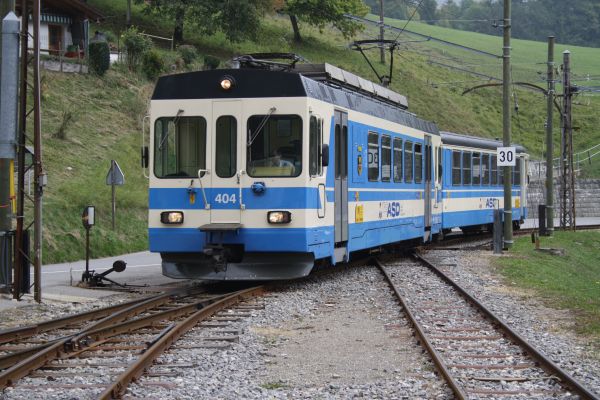
One of the same trains, this time no.404 approaching Le Sépey station, but now the train is in its original livery.
Picture by the German Wikipedia user "Roehrensee" 25.9.2009. Published under the
Creative Commons Attribution-Share Alike 3.0 Unported
license, version for Germany.
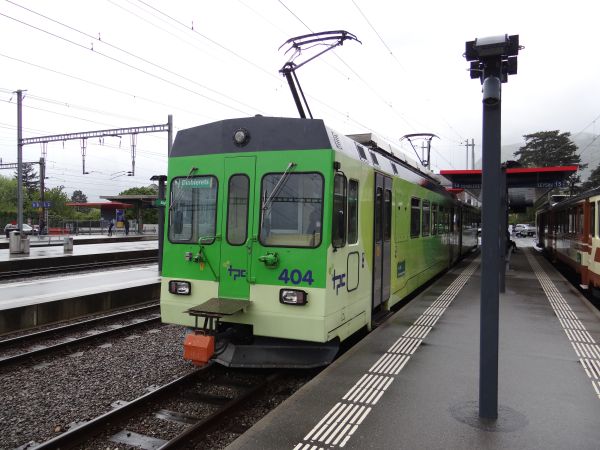
Exactly the same motor wagon ASD BDe 4/4 no.404 a couple of years later, now repainted in tpc's new green livery.
Picture from Aigle Gare 3.5.2016 by Ilkka Siissalo.
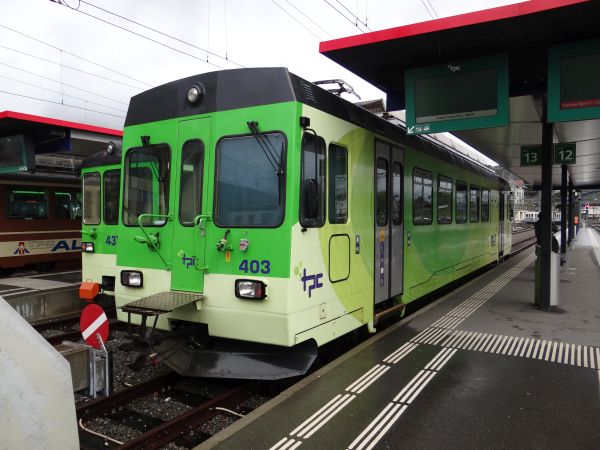
Again one of the same motorwagons, ASD's BDe 4/4 no. 403 this time.
Picture from Aigle Gare 3.5.2016 by Ilkka Siissalo.
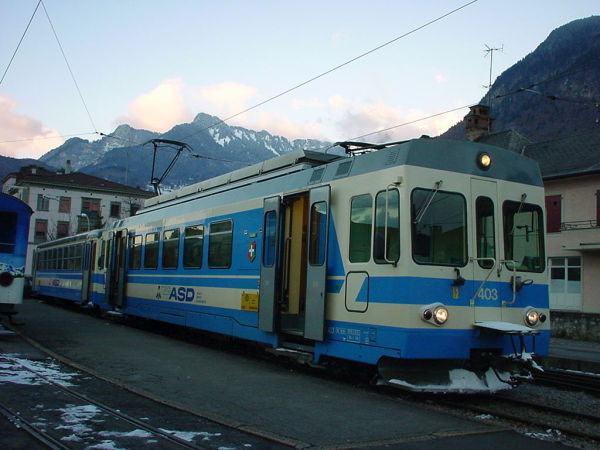
The same train, motorwagon 403 with its driving trailer, but now in 2001.
Picture from Aigle Gare 29.12.2001 by Ilkka Siissalo.
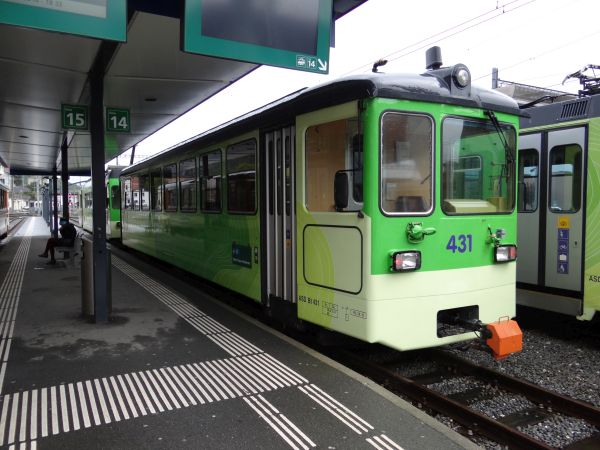
This steering cab wagon Bt 431 is from 1966. It used to belong to the BVB railroad as their no.26 before it was
taken over by ASD.Here it was coupled with the motor wagon BDe 4/4 403 which is shown above.
Picture from Aigle Gare 3.5.2016 by Ilkka Siissalo.
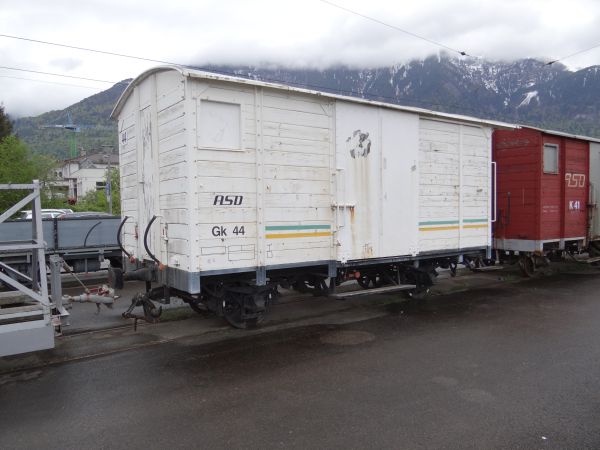
ASD's historic cargo wagons. The white Gk 44 is a cooler wagon, which used to be cooled with ice for transportation of
meat or dairy products.
Picture from the outskirts of Aigle 3.5.2016 by Ilkka Siissalo.
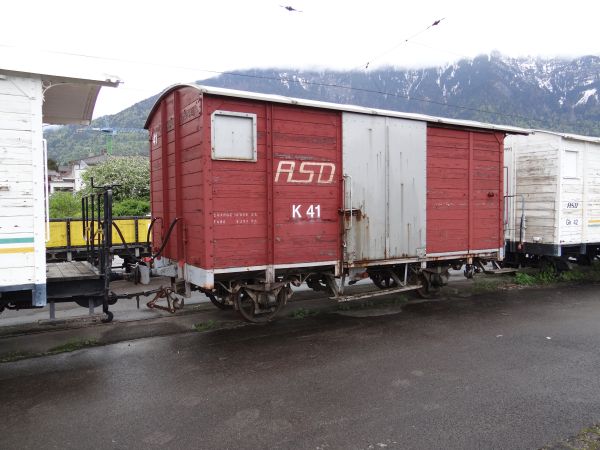
ASD's historic cargo wagon K41. Right from the beginning of the ASD railroad, they had cargo wagons, divided in the series G,
K, L and M. First there were hopes that ASD's and MOB's narrow gauge railroads would be connected, but as the wartime made
it clear that this was not going to happen in 1942, ASD decided to convert all cargo wagons from the Hardy brake system
(as then used by MOB) to Westinghouse brakes, so that these wagons would be compatible with cargo wagons of other narrow
gauge railroads around the Aigle region. The oldest cargo wagons of these types date back to 1914. The famous
builder of H0 scale model railway wagons and trains, Fulgurex, famous for very expensive hand made brass models, has made a
small series of ASD's K, L and M type of cargo wagons. This K41 was the original prototype and source of inspiration for
Fulgurex' models. Today those model wagons are extremely expensive, but in theory it is possible to buy this wagon in its
previous grey livery in H0 scale. This reddish brown livery is from the 1970s.
Picture from the outskirts of Aigle 3.5.2016 by Ilkka Siissalo.
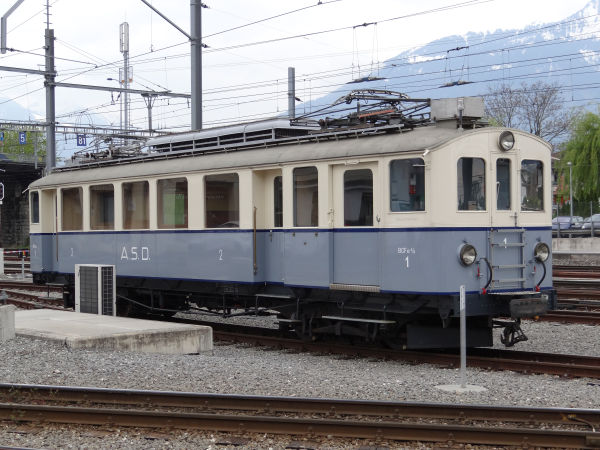
The historic motorwagon BCFe 4/4 no.1 of ASD is kept for historic and museal purposes. Here we see it outside tpc's new depot
at Aigle. It is the first one of three similar motorwagons which were taken in use in 1913 when the line from Aigle to La Sepey
was opened. A depot fire nearly totally destroyed this one in 1940 but it was rebuilt in 1941. For a long time this wagon was
painted orange with a narrow white band, but it has now been restored to look more or less like it used to look in 1913.
Picture from the outskirts of Aigle 2.5.2016 by Ilkka Siissalo.
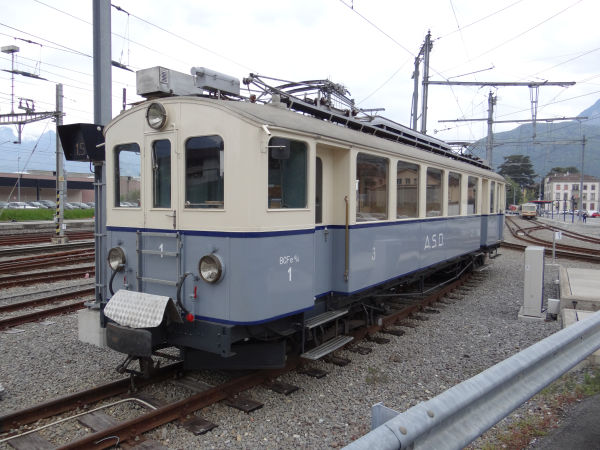
The same historic motorwagon BCFe 4/4 no.1 seen from the other direction.
Picture from the outskirts of Aigle 2.5.2016 by Ilkka Siissalo.
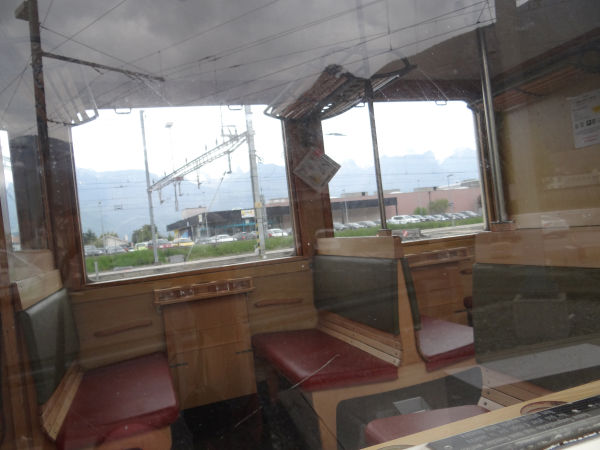
Inside view of the same BCFe 4/4 no.1 as shown above.
Picture from the outskirts of Aigle 2.5.2016 by Ilkka Siissalo.
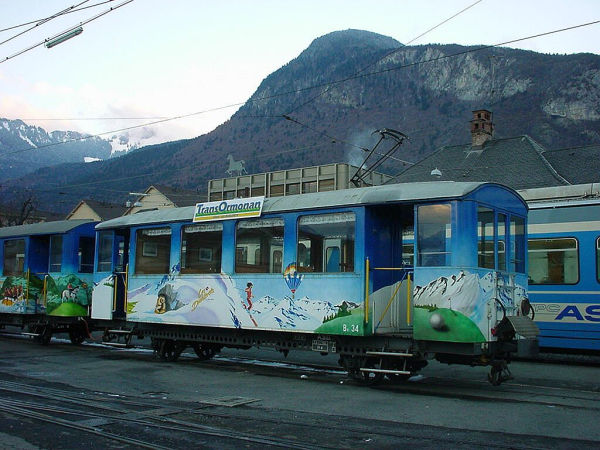
For quite some time ASD operated a special touristic train called "TransOrmonan". It consisted of very old and otherwise unused
passenger coaches with quite peculiar and colourful paintings on the outside. It was a marketing gag of the fairly famous restaurant
L´Ormonan which lies high up at the skiing resorts of Les Diablerets. TransOrmonan was their way to try to get more tourists to dine.
The same old and now stylish BCFe 4/4 no.1 motorwagon shown above used to be spoilt with similar colourful graffiti-like paintings
as it normally was used to haul these TransOrmonan coaches. Luckily it has now gotten its old colours back.
Picture from Aigle 23.12.2001 by Ilkka Siissalo.
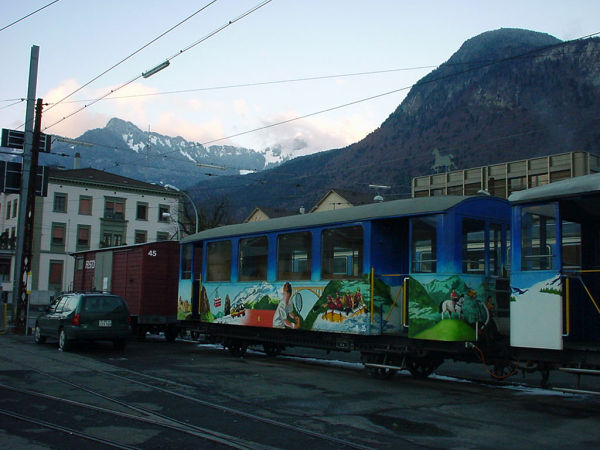
Another one of the TransOrmonan coaches back in 2001.
Picture from Aigle 23.12.2001 by Ilkka Siissalo.
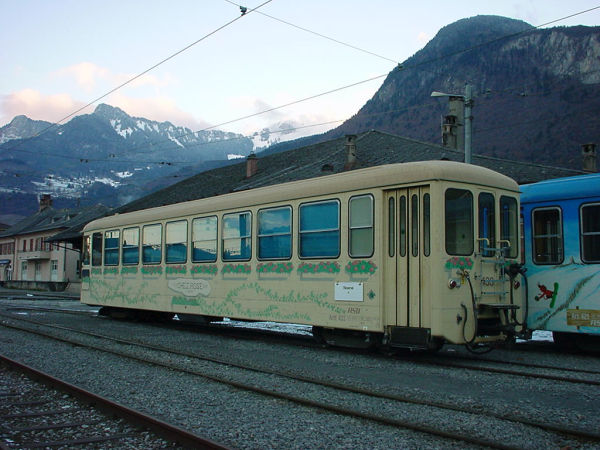
Back in 2001 ASD used to have some other exotically painted old coaches as well. This one was named "Chez Rose"...
Picture from Aigle 29.12.2001 by Ilkka Siissalo.
BVB - Bex-Villars-Bretaye railway
Bex–Villars–Bretaye railway (Chemin de fer Bex-Villars-Bretaye, BVB) is a metre gauge railway line operating
between the towns of Bex and Villars-sur-Ollon and the Col de Bretaye mountain pass, in the Chablais region
of southwest Switzerland. It is, in fact, two railways, one mixed adhesion and rack between Bex and Villars-sur-Ollon,
the other, linking Villars to the Col de Bretaye operated on the Abt rack system. Passengers making the full journey are
required to change trains at Villars.
BVB's line lenghth is 17,1 km of metre gauge rail, partly equipped with the Abt rack rail system, electrified with 700 V DC.
The line climbs up to 1810 metres above sea level. The part from Bex to Bévieux was built as a tram line and even today some
historic trams can be seen on that part. Those trams were taken over by the VBZ of the City of Zürich.

Beh 4/8 no.91 is one of the three newest trains, dating back to 2000-2001. This one is named "Bretaye". It's a fixed two-coach,
partly low-floor composition able to run both on adhesion rails and on rack rails of the Abt system. They were built by Stadler
and Ateliers Vevey. They are used in BVB's service from Bex to Villars-sur-Ollon. The service is also known as tpc's line B.
Picture from BVB's depot at Bévieux 3.5.2016 by Ilkka Siissalo.
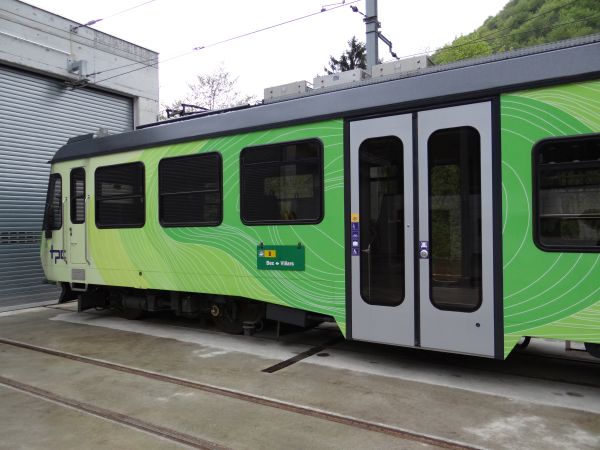
A detail picture of the same Beh 4/8 no.91.
Picture from BVB's depot at Bévieux 3.5.2016 by Ilkka Siissalo.
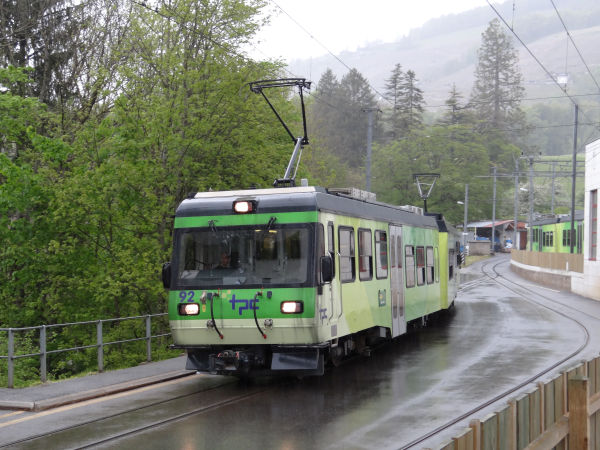
A similar Beh 4/8 but now the number 92 is passing here the BVB depot at Bévieux on its way to Bex.
Picture from BVB's depot at Bévieux 3.5.2016 by Ilkka Siissalo.
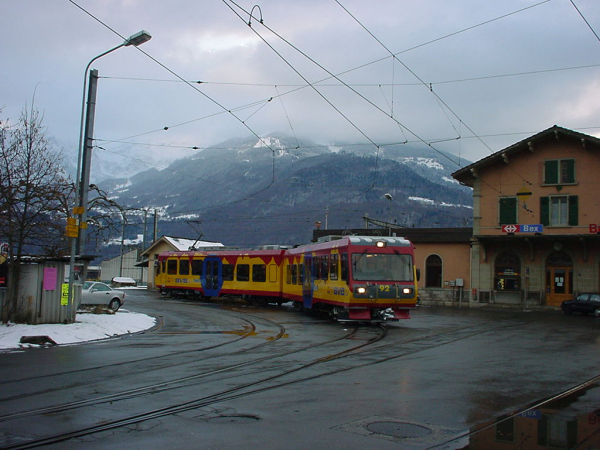
To show how it used to look like when it was new. This is the very same train, BVB's Beh 4/8 no.92, but seen here
as brand new in its first livery.
Picture from the station of Bex 29.12.2001 by Ilkka Siissalo.
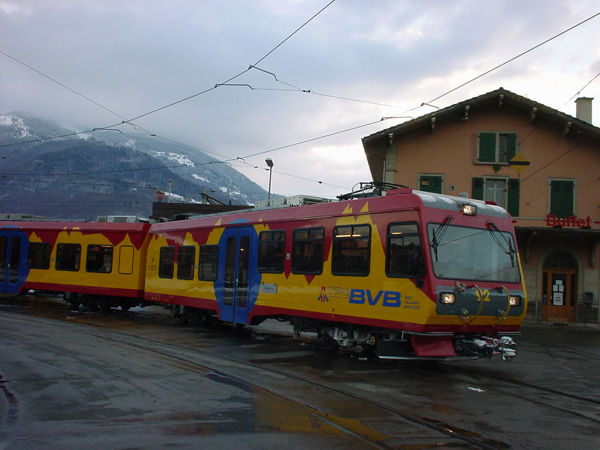
Same train, same place, but a closer look.
Picture from the station of Bex 29.12.2001 by Ilkka Siissalo.
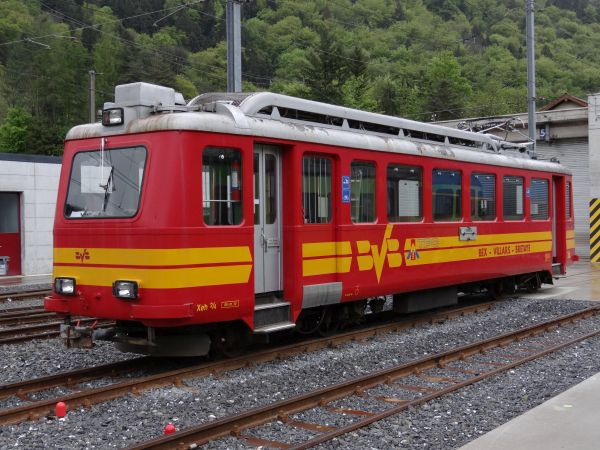
BVB's Xeh 2/4, formerly BDeh 2/4 is a former passenger motorwagon from the 1940s, now modified to work as a track maintenance
vehicle. It is still painted in the traditional BVB livery.
Picture from BVB's depot at Bévieux 3.5.2016 by Ilkka Siissalo.
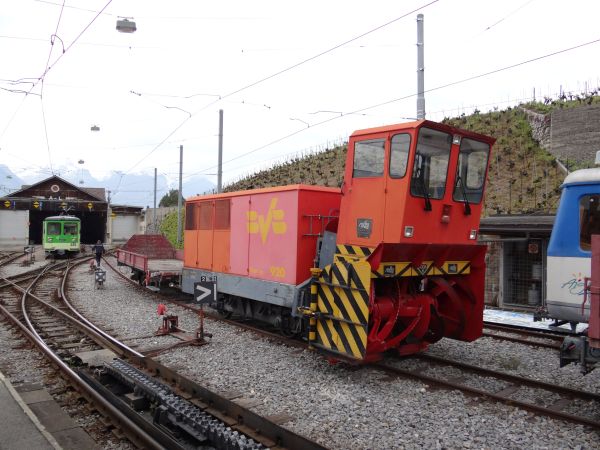
A rotary snowplough Xrotm 920 of the BVB Bex-Villars-Bretaye railway, now parked at the depot of AL, Aigle - Leysin railway.
In the background one of the AL trains, now painted in tpc's green and white livery.
Picture from Aigle 2.5.2016 by Ilkka Siissalo.
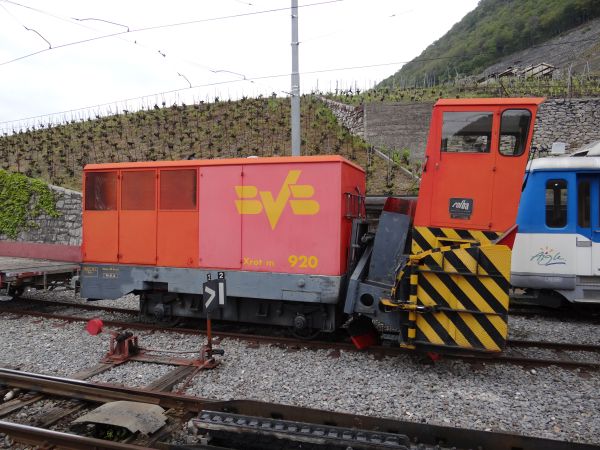
A second view of the same BVB rotary snowplough Xrotm 920. Note the two brushes under the machine, which wipe the last remaining
snow away from tracks after the rotary system has blown most of it away. The text says that the machine was built by the company
Rolba.
Picture from Aigle 2.5.2016 by Ilkka Siissalo.
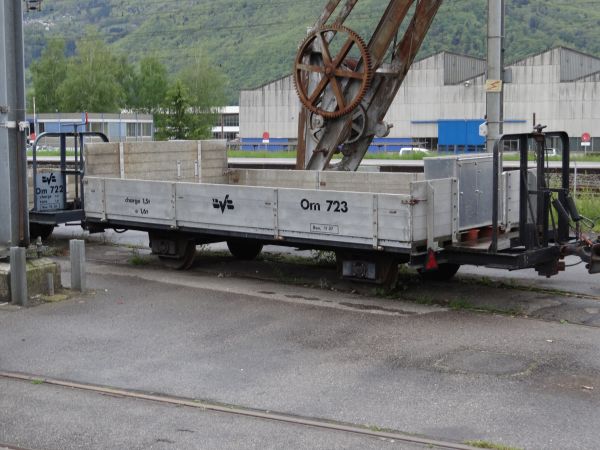
BVB's open cargo wagons, used during track maintenance works.
Picture from the outskirts of Aigle 3.5.2016 by Ilkka Siissalo.
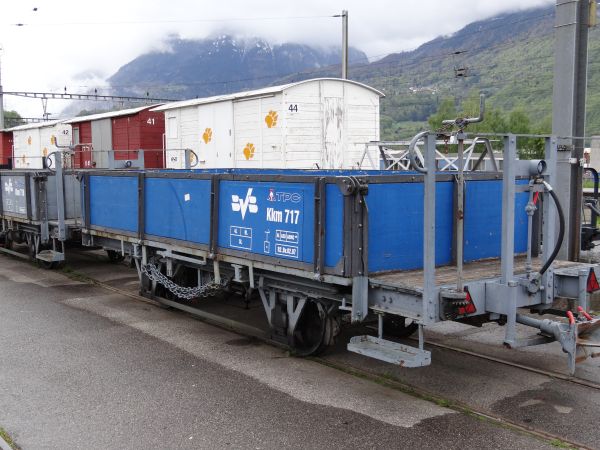
A newer open cargo wagon Kkm 717 of BVB. Note how they all have a walking bridge and a manual brake shaft. The couplers between
wagons resemble those of many tram systems.
Picture from the outskirts of Aigle 3.5.2016 by Ilkka Siissalo.

BVB's By 881 is an open-air touristic coach which can be attached to BVB's passenger trains during warm weather.
Picture from BVB's depot at Bévieux 3.5.2016 by Ilkka Siissalo.
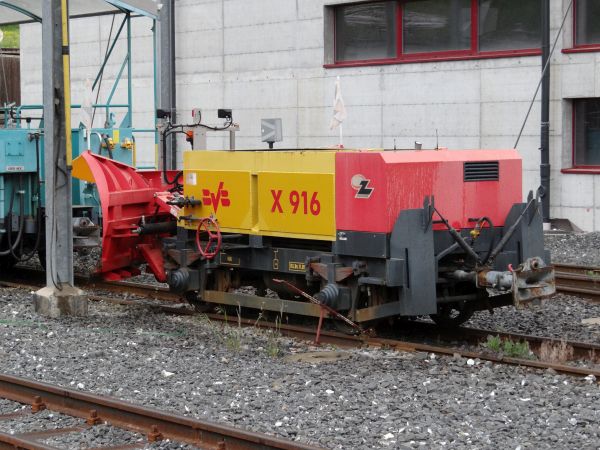
BVB's snow plough X 916 is an interesting composition, built on top of an old passenger coach bogie. It has its own small
diesel engine and it is used mainly to plough snow out of the way at BVB's depot at Bévieux.
Picture from BVB's depot at Bévieux 3.5.2016 by Ilkka Siissalo.

